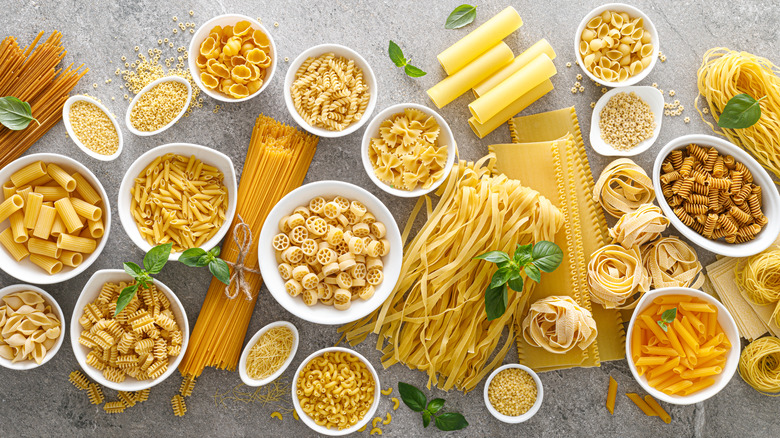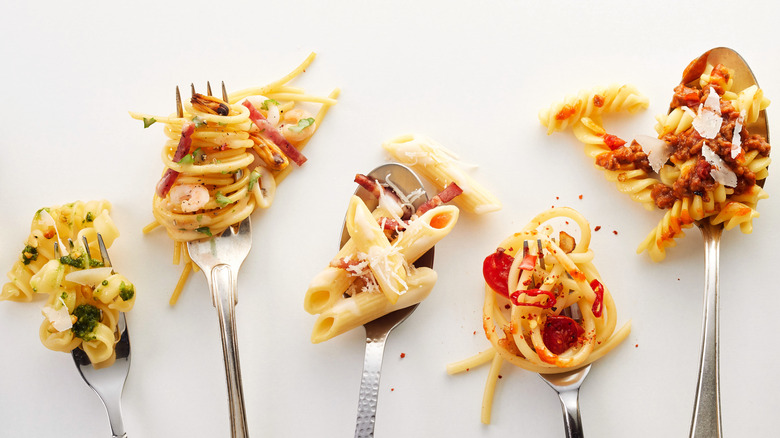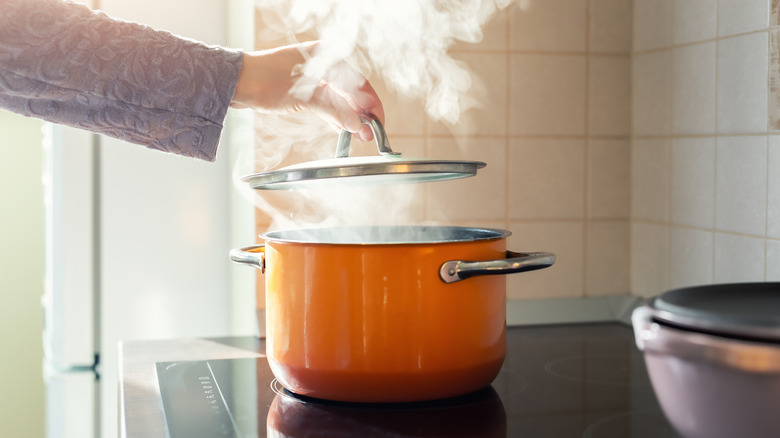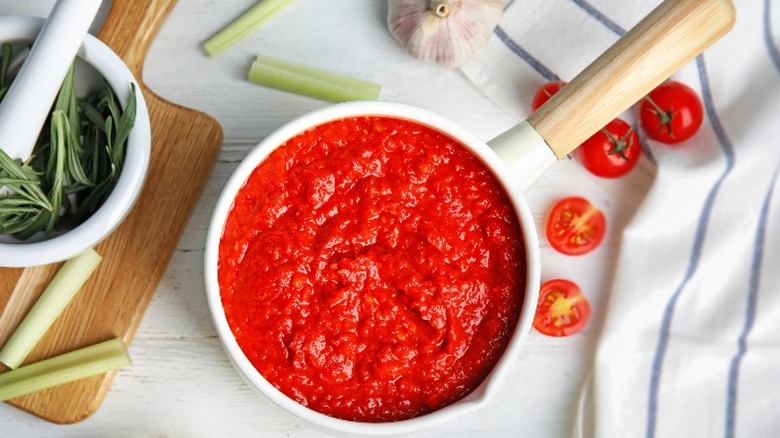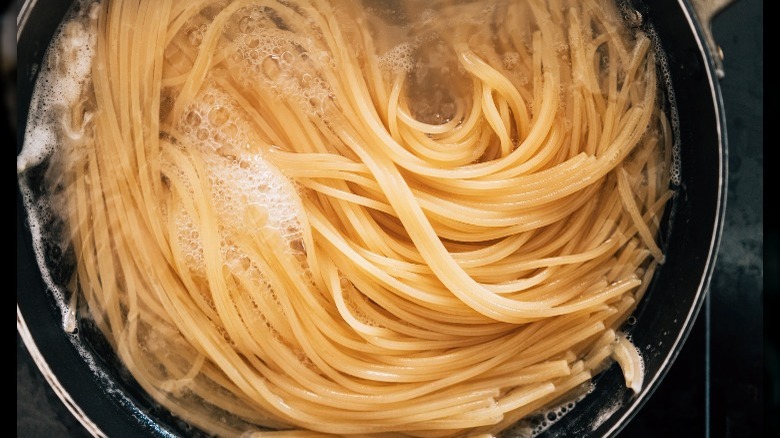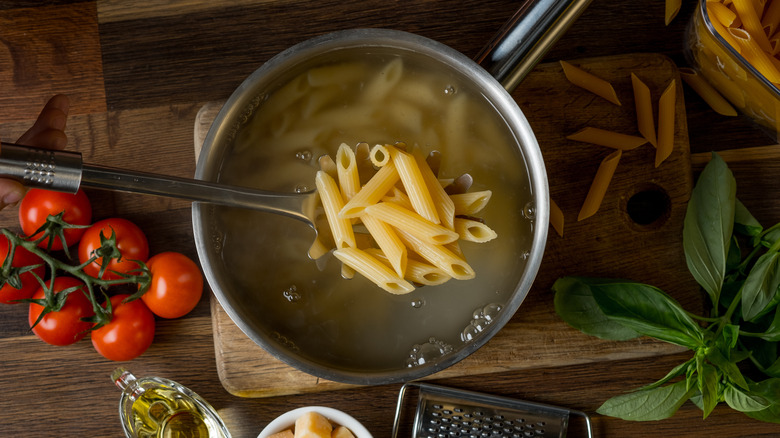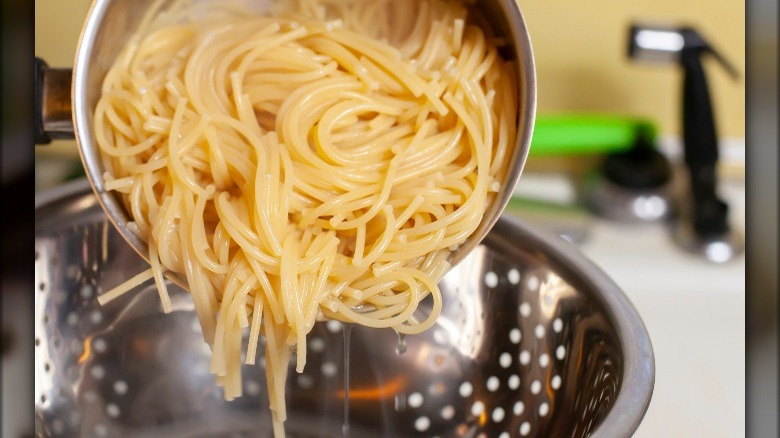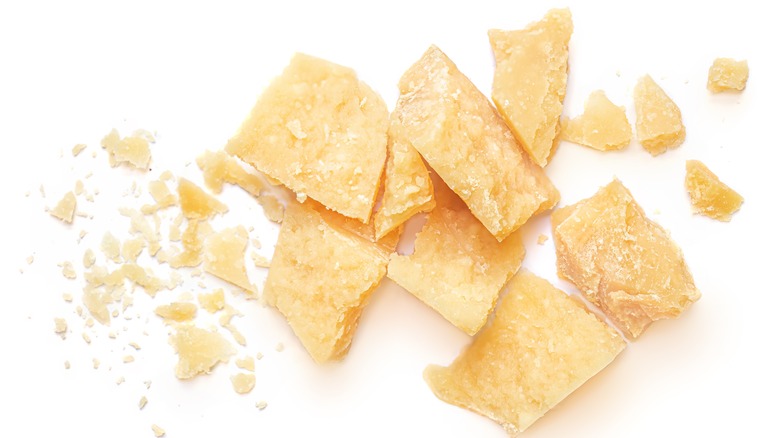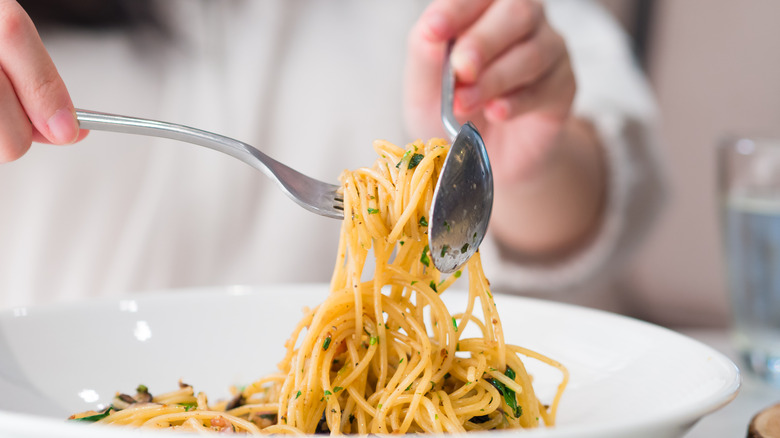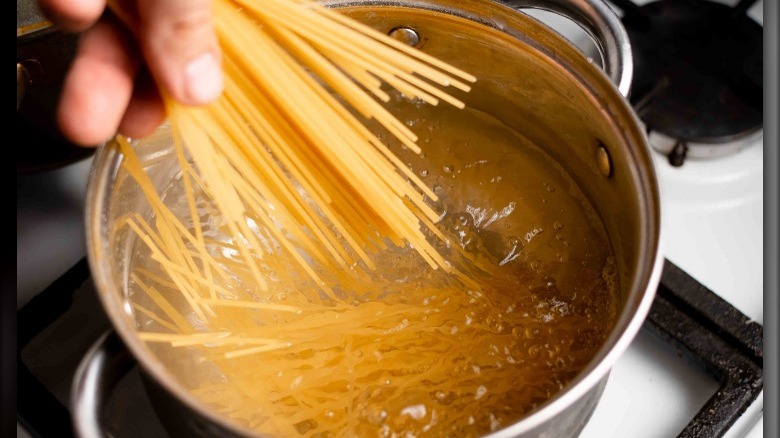10 Pasta Rules You Should Never Break
No matter where you are on your cooking journey, one of the first dishes you likely learned how to make is pasta. The grocery store has made it quite easy to whip together some spaghetti and marinara sauce on a weekday evening, and pasta is universally recognized as something that is ready in very little time, only requiring a couple of ingredients. Of course, pasta can be much more complex than that, especially if you get into making your own pasta from scratch, but in general, there are several corners you can cut along the way. However, that can lead many into some common pitfalls and major rule-breaking when it comes to cooking pasta.
Cooking pasta perfectly does not require a ton of advanced skill, but it does mean paying close attention to some of the cardinal rules of pasta and making sure you do not break them. Whether you are looking for a new pasta recipe to make this week or you are perfecting your current go-to meal plan, be sure to keep your eyes peeled for these guidelines the next time you boil up some water and toss in your favorite noodles.
1. Do not treat all pasta types the same
One of the ways in which no two pasta dishes are quite the same is because pasta comes in all different shapes and sizes. From spaghetti to penne, simply switching out what kind of pasta you use can change the overall presentation and texture of a dish. Because of this, you should never approach pasta in a one size fits all approach.
Of course, different pasta shapes will require different cooking times, so be sure to read your package instructions carefully when boiling pasta. The shape of the pasta that you use in your dish can also have an impact on the kind of sauce you use to pair with the dish. That is right; it is not as simple as tossing any kind of pasta with any kind of red sauce and calling it a day. The differences do not stop at just the shape of the pasta, either. You can use dry pasta, egg dough, or even make your own fresh noodles. Each kind of pasta can have a different flavor from the next. So, it's crucial that you know exactly what kind of pasta you are cooking because it can impact the best sauce or ingredients to include in the finished dish.
2. Boil the proper amount of water
Pasta is one of the easiest dishes to make when you do not have a lot of time, particularly in the middle of the work week, to make dinner for yourself or for others. But one of the important rules that is often overlooked is just how much water you add to your pot before turning the stove on to boil. After all, if the water is going to be strained in the end, what should it matter?
It matters a great deal, in fact, perhaps more than you realize. Cooking your pasta in too much water can have a negative impact, especially if you are going for a thicker sauce. As the pasta boils, starches are released into the liquid, which is exactly what you want if you're emulsifying it with your sauce. But if you have too much water, the starch will be stretched too thin. Boil in less water for a starchier liquid, thus a thicker, less runny sauce that clings to the pasta better.
So, what is the proper water-to-pasta ratio? The box that the pasta comes in might tell you the ideal amount. However, it is important to keep in mind that in general, thin pasta like spaghetti will bode well in higher quantities of liquid than shorter pasta like penne.
3. Cook your sauce first
There are few things more satisfying than all of the components of your meal coming together at the same time. So, the temptation may be there to time your pasta so that it finishes boiling around the same time that you would consider your sauce to be done heating up. Sure, your sauce will probably taste just fine if you heat it up as your pasta cooks, but if you really want to level up your pasta, make sure you cook your sauce well before you drop a single noodle into the pot.
Cooking your sauce first will only allow for the flavors to become more robust. Like any good stock, soup, or stew, low and slow is key. Also, giving your sauce as much time as possible can result in a thicker consistency. Plus, if you get it cooking ahead of time, you can also borrow a technique from the pros and finish your pasta in the sauce. This means that you drain your pasta before it's completely cooked in the water. Then, add it to your already simmering sauce to finish cooking it and infuse a delectable flavor.
4. Add salt to your boiling pasta water (never oil)
One of the most important flavor profiles that can make or break any dish is salt. So, it should come as no surprise that salt is going to play a crucial role in the making of a perfect bowl of pasta. Culinary queen Martha Stewart recommends generously salting your boiling water prior to adding pasta to ensure each noodle is evenly seasoned. While adding too much sodium might give health-conscious home cooks pause, keep in mind that the pasta will absorb only a small fraction of the salt. And don't hesitate to use a heavy hand when pouring in the salt. Your pasta water needs more salt than you probably think to achieve flavorful results.
Plain, dry pasta is practically flavorless, so it is going to need a lot of seasoning in order to elevate to a restaurant-quality meal. Do not be afraid to add a couple of tablespoons of salt to your pot. Be mindful of what kind of salt you have in your pantry and if the recipe calls for any specific kind of salt, as that can also make a difference in how much you add. And resist the urge to add oil to a boiling pot of pasta to prevent sticking. It will only cause the sauce to slide right off, which is the exact opposite of what you want to happen.
5. Cook your pasta al dente, no more and no less
When it comes to texture, one of the most important steps in cooking pasta is getting the timing correct. If you take your pasta out of the boiling water too soon, it will be chewy and hard. But if you wait too long, your pasta will be soft and squishy. That Goldilocks space in between the two is considered al dente, or "to the tooth" in Italian.
Al dente is the level of doneness you want to aim for when cooking pasta. Basically, not too hard but definitely not too soft. The package instructions that come with boxed dry pasta will tell you the amount of time to boil your noodles in order to reach al dente. However, it is recommended that you pull the pasta out of the water even sooner than that to test it. Keep in mind, if you are adding your noodles to a hot sauce they will continue to cook in those last few moments. So, if your pasta is already al dente, that extra cooking time could lead to your pasta being overcooked. Barilla also points out that taking care to not overcook pasta helps keep the pasta's glycemic index low, improving the digestive process.
6. Always add pasta water to your sauce
When you have boiled your pasta for the proper amount of time and you are ready to drain the pot, there is one key step you want to make sure you do not skip. It may seem counterintuitive to add water to your sauce, especially if the desired goal is a thick, robust sauce. But reserving a small amount of pasta water makes a huge difference in how the dish ultimately emulsifies.
Multiple professional and expert chefs agree that pasta water is an important addition to any dish, considering that it is essentially a seasoning with all of the salt and starches released from the noodles. That combination of liquid and starch makes for a perfect binding agent that helps thicken the sauce and better stick to the pasta. You can also save your pasta water and use it as a thickening agent for soups and stews. Ultimately, you do not want to make the error of simply dumping all of the pasta water you worked so hard for down the drain.
7. Do not rinse your pasta after cooking
Some experts suggest removing your cooked pasta from the pot using tongs and reserving the leftover water for future use. But most of us will probably opt for straining the pasta in the sink after we have reserved a bit of the water for the sauce. This is where the next rule for making the perfect bowl of pasta comes in: Never, under any circumstances, rinse your pasta once it is strained out of the pot.
Multiple steps in the pasta cooking process helps to create a sticky surface on the noodles that the sauce can cling to, giving you that restaurant-quality experience with every bite. Rinsing the pasta once it is strained will only wash that starchy solution away, and all you are left with are wet noodles with no ability to stick to the sauce you worked so hard at making. You may not realize it, but rinsing cooked pasta is actually a pretty consequential bad cooking habit that you are better off leaving behind. When your pasta is done cooking, simply strain it and then immediately move it into another pot as-is.
8. Never use pre-grated parmesan
Pasta is an incredibly versatile dish that can be paired with a number of different sauces and toppings. But one of the most classic pairings is good old marinara sauce with parmesan cheese. Done right, this simple dish can be oh-so-satisfying. But because these ingredients are so readily available at your local supermarket, you may be tempted to go down the easy route and purchase the somewhat more shelf-stable, plastic jar of pre-grated parmesan cheese.
There is a time and a place for pre-grated cheese, but perfecting a bowl of pasta is not one of those times. Fresh cheese, for starters, does not contain any cellulose, also known as wood pulp, or any of those unpleasant additives, nor does it melt in the way you want it to. When you are in the grocery store, take a look at the ingredients listed on the cheese you are looking to buy. Ideally, there will only be a few listed. Basically, buying pre-grated parmesan isn't going to give you the best taste possible, not to mention that it's likely not the most nutritious option.
9. Twirl your spaghetti instead of cutting
Pasta comes in a variety of shapes and sizes, each with a certain degree of difficulty when going in for a bite. Some pasta, like penne and rotini, are rather simple and straightforward to eat. But once you start to tackle those long, thin noodles like spaghetti, linguine, and angel hair, the question may arise: Do you twirl, or do you cut the pasta? After all, it can be a pain when you wind up slurping each strand of spaghetti like you are in a scene from "Lady and the Tramp."
If you want to eat as the Italians do, then the answer to the above is simple: As a spaghetti-eating rule, never cut it, and always twirl it on your fork. While cutting your pasta into smaller pieces seems like a good hack to make a long, stringy piece of pasta easier to eat, you are actually committing a big no-no in Italian cuisine. So the next time you are serving spaghetti at your house, teach your family members the proper method of getting an easy bite full.
10. Do not break your spaghetti before boiling
All of the tips and rules we have shared so far can help you make a bowl of pasta that can rival that of any top-notch Italian restaurant you will find. Pasta that is just so-so is a pretty simple dish to make, which is why you may often find a lot of these rules are skipped or broken. But taking just a few more moments in your preparation to follow these rules can make all of the difference in the world. If you are making a bowl of spaghetti for dinner, there is one huge rule that you need to make sure you follow, and that is to make sure you do not break your spaghetti in half.
Adding dry spaghetti to a pot of boiling water can present an immediate conundrum: How do you fit the noodles into the pot? They are, after all, much taller than the pot, and half of the spaghetti will stick out awkwardly. But breaking the pasta is a major no-no because it defeats the sole purpose and method of eating spaghetti in the first place, which is to twirl it around your fork. Instead, make sure you have a pot large enough to accommodate the spaghetti, and you will find that it easily fits shortly after you add it to the boiling water and the pasta begins to soften.
